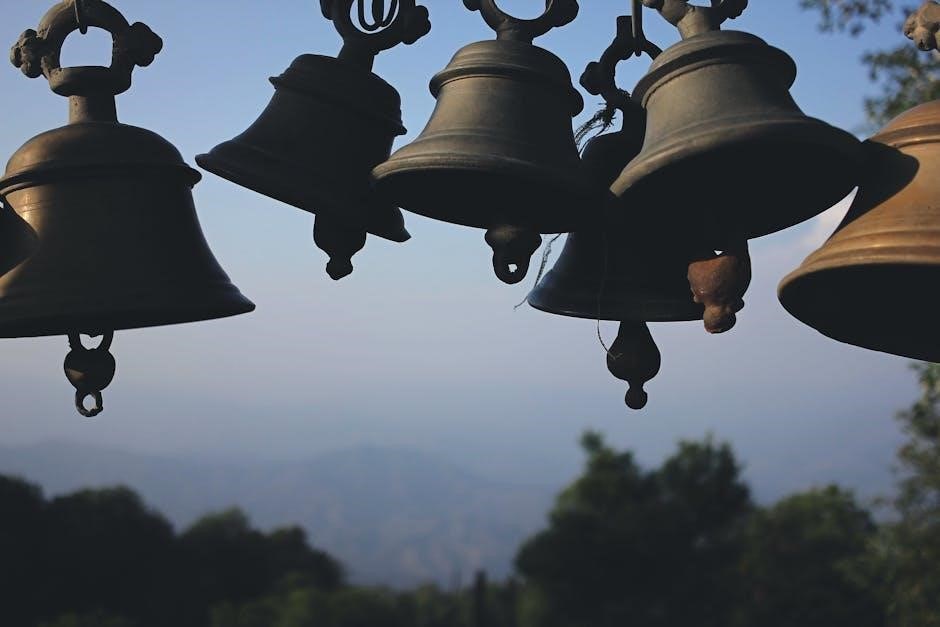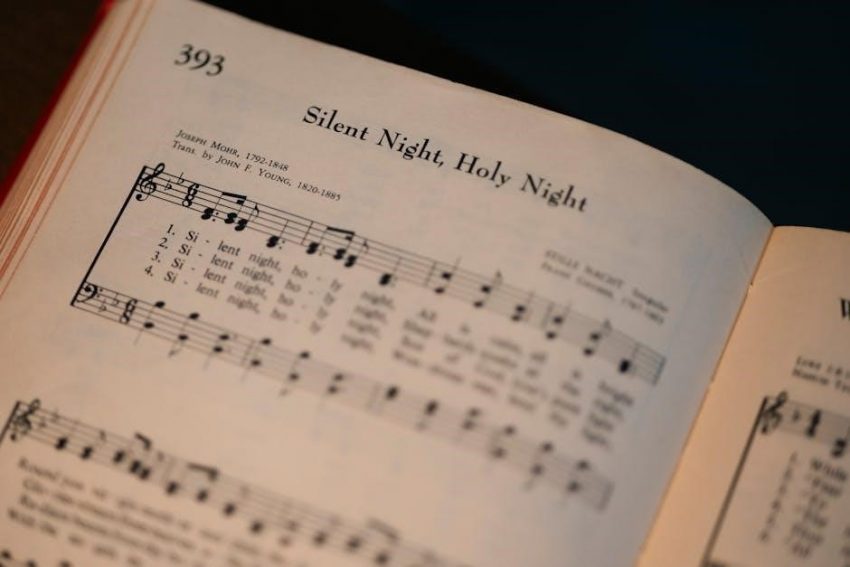Historical Background of “Carol of the Bells”
Composed by Mykola Leontovych in 1916‚ “Carol of the Bells” originated from the Ukrainian folk chant “Shchedryk.” Initially a New Year’s song‚ it evolved into a Christmas carol with Peter J. Wilhousky’s 1936 English lyrics‚ emphasizing the ringing of bells and festive cheer‚ becoming a global holiday classic.
1;1 Origin and Evolution
Originating from the Ukrainian folk chant “Shchedryk‚” “Carol of the Bells” was composed by Mykola Leontovych in 1916. Initially a New Year’s song‚ it evolved into a Christmas carol with Peter J. Wilhousky’s 1936 English adaptation‚ transforming its focus to bells and festive cheer‚ gaining global popularity.
1.2 The Composer: Mykola Leontovych
Mykola Leontovych‚ a renowned Ukrainian composer‚ created the melody for “Carol of the Bells” in 1916‚ basing it on the traditional folk chant “Shchedryk.” His work masterfully blends Ukrainian folk elements with classical techniques‚ making it distinctive and enduring‚ leading to its global recognition as a Christmas classic.
1.3 The Lyricist: Peter J. Wilhousky
Peter J. Wilhousky‚ an American composer of Ukrainian descent‚ wrote the English lyrics for “Carol of the Bells” in 1936. Inspired by the melody’s resemblance to ringing bells‚ he crafted verses that captured the festive spirit‚ transforming the song into a beloved Christmas carol enjoyed worldwide.

Composition and Creation
Mykola Leontovych composed “Carol of the Bells” in 1916‚ adapting the Ukrainian folk chant “Shchedryk.” Peter J. Wilhousky later added English lyrics in 1936‚ transforming it into a Christmas carol.
2.1 The Original Folk Chant “Shchedryk”
“Shchedryk‚” a traditional Ukrainian folk chant‚ inspired Leontovych’s composition. Originally a New Year’s song about a swallow‚ it featured four-note ostinatos mimicking bell sounds‚ later adapted into “Carol of the Bells” with Wilhousky’s Christmas-themed lyrics‚ transforming its cultural and musical significance globally.
2.2 The Transition to an English Carol
In 1936‚ Peter J. Wilhousky‚ an American composer of Ukrainian descent‚ adapted “Shchedryk” into “Carol of the Bells.” He wrote new English lyrics‚ shifting the focus from the swallow tale to Christmas bells‚ creating a festive carol that gained global popularity while preserving the original melody’s traditional charm and cultural essence.
2.3 The Musical Structure and Chord Progression
“Carol of the Bells” features a haunting four-note ostinato in 3/4 time‚ mimicking the pealing of bells. The chord progression transitions between minor and major keys‚ creating a dramatic yet festive atmosphere. This unique structure‚ combined with its rhythmic intensity‚ contributes to the song’s enduring appeal and emotional impact during the holiday season.

Lyrics and Their Meaning
The lyrics describe the joyful ringing of bells‚ symbolizing Christmas cheer and unity. Adapted from a Ukrainian folk chant‚ they emphasize festive celebration and timeless harmony‚ resonating universally.
3.1 The Original Ukrainian Lyrics
The original Ukrainian lyrics of “Shchedryk” speak of a swallow’s visit to a household‚ symbolizing prosperity and spring. These verses‚ rooted in folklore‚ were later transformed by Peter J. Wilhousky into the familiar Christmas carol‚ “Carol of the Bells‚” emphasizing bells’ joyful ringing and festive spirit‚ while retaining the melodic essence.
3.2 The English Adaptation by Wilhousky
Peter J. Wilhousky adapted “Shchedryk” into “Carol of the Bells” in 1936‚ crafting English lyrics that emphasized the ringing of bells and festive cheer. His version transformed the original Ukrainian folk song into a global Christmas standard‚ focusing on the joyful tones of bells announcing the arrival of Christmas.
3.3 Interpretation of the Lyrics
The lyrics of “Carol of the Bells” symbolize joy and celebration‚ with bells ringing out across landscapes‚ spreading cheer and unity. They evoke a sense of community and festive spirit‚ capturing the essence of Christmas through the imagery of bells and collective singing‚ resonating universally across cultures and generations.

Musical Arrangements and Versions
The SATB choir version‚ arranged by Peter J. Wilhousky‚ features four-part harmony for soprano‚ alto‚ tenor‚ and bass. It captures the song’s haunting beauty with a cappella vocals‚ making it a beloved choice for choir performances and a staple in holiday repertoires worldwide.
4.2 Instrumental Arrangements
Instrumental arrangements of “Carol of the Bells” vary widely‚ from piano solos to orchestral versions. These arrangements highlight the melody’s versatility‚ often featuring bells‚ strings‚ or brass‚ creating rich‚ dynamic interpretations that preserve the song’s iconic four-note ostinato and festive spirit across different musical genres and settings.
4.3 Modern Covers and Remixes
Modern artists have reimagined “Carol of the Bells” across genres‚ from rock to electronic. These covers often blend traditional melodies with contemporary beats‚ showcasing the song’s timeless appeal. Remixes frequently incorporate synthesizers‚ drum machines‚ and orchestral elements‚ creating fresh‚ dynamic interpretations that attract new audiences while honoring the original composition’s essence.

Cultural and Historical Significance
“Carol of the Bells” holds deep cultural significance as a Ukrainian folk-inspired carol‚ symbolizing tradition and heritage. Its global recognition as a Christmas classic highlights its universal appeal‚ bridging cultural boundaries and becoming a timeless holiday staple worldwide.
5.1 The Song’s Role in Ukrainian Culture
“Carol of the Bells” is deeply rooted in Ukrainian culture‚ originating from the folk chant “Shchedryk‚” which symbolizes prosperity and renewal. Composed by Mykola Leontovych‚ it reflects traditional Ukrainian folklore and musical heritage‚ becoming a source of national pride and cultural identity‚ both historically and in modern times.
5.2 Its Global Popularity and Recognition
“Carol of the Bells” has gained worldwide acclaim‚ transcending cultural boundaries. Its haunting melody and universal theme of celebration resonate globally‚ making it a staple in holiday playlists and performances. The song’s adaptability across genres and languages has cemented its status as a beloved Christmas classic‚ enduring for generations.
5.3 Use in Media and Popular Culture
“Carol of the Bells” has been prominently featured in films‚ TV shows‚ and commercials‚ enhancing its global appeal. Its haunting melody appears in “Home Alone” and “The Lord of the Rings‚” while its adaptation in commercials evokes festive nostalgia. The song’s versatility across genres makes it a popular choice for media and cultural references.

The PDF Version and Its Availability
The PDF version of “Carol of the Bells” includes lyrics and sheet music‚ available for free download on various platforms like VK and NATO‚ ensuring easy access for enthusiasts.
6.1 Sheet Music and Lyrics in PDF Format
The PDF version of “Carol of the Bells” includes the full sheet music and lyrics‚ arranged for SATB choir and instruments. It features the iconic four-note ostinato and festive lyrics‚ making it a popular choice for Christmas performances. The file is widely available for free download and printing.
6.2 Where to Download the PDF
The PDF version of “Carol of the Bells” can be downloaded from various platforms such as ruwiki.org and vk.cc. These sites offer free sheet music and lyrics‚ ideal for choir performances and personal use‚ ensuring accessibility for all music enthusiasts.
6.3 Printing and Performance Tips
For optimal printing‚ use high-quality paper and ensure proper margins. Choirs should emphasize precise rhythm and harmony‚ capturing the bell-like chimes. Consider a cappella arrangements or add instruments like bells or piano for enhanced melody. Ensure all parts are balanced‚ especially the four-part harmony‚ to maintain the song’s festive and resonant appeal.

Modern Adaptations and Covers
The carol has inspired numerous modern adaptations‚ including orchestral collaborations and contemporary artist interpretations. Its versatility across genres like pop‚ rock‚ and electronic keeps it timeless and fresh.
7.1 Contemporary Artists’ Interpretations
Contemporary artists have reimagined “Carol of the Bells” with fresh perspectives‚ blending genres like pop‚ rock‚ and electronic music. Groups like Pentatonix and Trans-Siberian Orchestra have delivered stunning a cappella and orchestral versions‚ while Lindsey Stirling’s violin rendition adds a dynamic‚ modern twist‚ showcasing the song’s enduring appeal across generations and musical styles.
7.2 The Song’s Versatility Across Genres
“Carol of the Bells” has transcended traditional boundaries‚ adapting seamlessly into various genres. From classical orchestras to rock bands and electronic artists‚ the melody’s haunting four-note motif remains intact while embracing diverse styles‚ proving its universal appeal and timeless adaptability in modern music landscapes.
7.3 Collaborations and New Versions
“Carol of the Bells” has inspired countless collaborations and new versions. Artists like Pentatonix and Lindsey Stirling have created unique renditions‚ blending a cappella and instrumental styles. The song has also been reimagined in rock‚ jazz‚ and electronic genres‚ showcasing its timeless appeal and versatility across musical boundaries.

Educational and Performance Aspects
“Carol of the Bells” is widely taught in schools for its harmonic complexity and cultural significance. Its adaptability makes it a favorite in choir performances‚ blending tradition with modern interpretations‚ ensuring its enduring educational and performance appeal globally.
8.1 Teaching the Song in Schools
“Carol of the Bells” is a popular choice for music education‚ offering insights into harmonic structure and cultural heritage. Its four-part SATB arrangement challenges students to master layered vocals‚ while its rhythmic patterns and festive theme engage learners‚ making it a valuable tool for developing choral skills and appreciation of traditional music.
8.2 Performance Techniques and Challenges
Performing “Carol of the Bells” demands precision in timing and dynamics‚ as its intricate bell-like harmonies require synchronized breathing and vowel placement. The piece’s a cappella nature highlights the importance of pitch accuracy and blend‚ while its ostinato motif challenges singers to maintain rhythmic unity without overpowering other sections‚ ensuring a cohesive performance.
8.3 The Song’s Role in Choir Repertoire
“Carol of the Bells” remains a timeless favorite in choral music‚ often featured in holiday performances. Its layered harmonies and rhythmic complexity make it a showcase for vocal technique‚ while its festive theme enhances seasonal programs‚ solidifying its place as a cornerstone of choir repertoire worldwide.

Digital Availability and Sharing
“Carol of the Bells” lyrics and sheet music are widely available as PDF downloads online‚ accessible through various platforms and websites‚ making it easy to share and perform legally.
9.1 The Song’s Presence on Digital Platforms
“Carol of the Bells” is widely available on digital platforms‚ with its lyrics and sheet music in PDF and MIDI formats accessible for free download on music-sharing websites and social media.
9.2 Sharing and Distributing the PDF
The PDF version of “Carol of the Bells” can be easily shared via email‚ social media‚ or cloud platforms like Google Drive or Dropbox. It is widely distributed among musicians and choirs‚ ensuring accessibility for performances and practice‚ with its lyrics and sheet music readily available online.
9.3 Legal and Copyright Considerations
Ensure that sharing and distributing “Carol of the Bells” PDF adheres to copyright laws. Original compositions and arrangements may require permission from copyright holders. Always verify the source and terms of use to avoid infringement‚ respecting intellectual property rights of composers and arrangers like Leontovych and Wilhousky.

Audience Reception and Impact
Audiences worldwide resonate with the joyful‚ haunting melody of “Carol of the Bells‚” evoking Christmas spirit and timeless appeal‚ transcending generations with its universal emotional impact and festive charm.
10.1 Public Perception and Emotional Response
The carol is widely cherished for its uplifting melody and nostalgic appeal‚ resonating deeply during Christmas. Its haunting yet beautiful chimes evoke joy‚ unity‚ and festive spirit‚ making it a beloved holiday staple that connects people across generations and cultures.
10.2 The Song’s Association with Christmas
“Carol of the Bells” is deeply linked to Christmas‚ evoking festive joy and nostalgia. Its adaptation by Peter J. Wilhousky in 1936 transformed it into a holiday classic‚ emphasizing bells and cheer‚ making it a timeless symbol of the season’s spirit and celebration worldwide.
10.3 Its Enduring Appeal Across Generations
“Carol of the Bells” captivates audiences of all ages with its timeless melody and universal themes of joy. Its haunting four-note motif and festive lyrics create an emotional connection‚ making it a cherished holiday tradition. Adaptations in films‚ TV‚ and modern covers ensure its relevance‚ bridging generational gaps and enduring as a cultural treasure.
“Carol of the Bells” remains a timeless holiday classic‚ blending rich cultural heritage with universal appeal. Its availability in PDF ensures its legacy endures‚ inspiring future generations to embrace its harmonious beauty and festive spirit.
11.1 Summary of the Song’s Significance
“Carol of the Bells” holds deep cultural and historical significance‚ originating from a Ukrainian folk chant and evolving into a global Christmas carol. Its enduring popularity stems from its haunting melody and joyful lyrics‚ symbolizing unity and festivity across generations and cultures‚ making it a cherished holiday tradition worldwide.
11.2 Final Thoughts on Its Enduring Popularity
“Carol of the Bells” remains timeless due to its haunting melody and universal appeal. Its adaptation across genres and cultures‚ coupled with its emotional resonance‚ ensures its continued relevance. The song’s versatility and ability to evoke festive joy solidify its place as a beloved global holiday tradition for generations.

